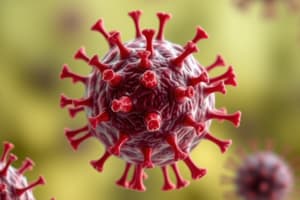Podcast
Questions and Answers
Which cells are involved in innate immunity among the following?
Which cells are involved in innate immunity among the following?
- Plasma cells
- T cells
- B cells
- Natural killer cells (correct)
Which type of immunity is characterized by the production of diverse receptors that bind specifically to antigens?
Which type of immunity is characterized by the production of diverse receptors that bind specifically to antigens?
- Barriers to entry
- Flora
- Adaptive immunity (correct)
- Innate immunity
What is one characteristic of adaptive immunity that is not shared with innate immunity?
What is one characteristic of adaptive immunity that is not shared with innate immunity?
- Inflammatory reactions
- Physical and chemical barriers
- Pathogen-specific
- Has memory (correct)
Which components are part of innate immunity among the following?
Which components are part of innate immunity among the following?
Which is a barrier that prevents the entry of harmful microbes according to the text?
Which is a barrier that prevents the entry of harmful microbes according to the text?
What is the main function of complements in the immune system as mentioned in the text?
What is the main function of complements in the immune system as mentioned in the text?
Which type of immunity is present before any exposure to pathogens and is effective from the time of birth?
Which type of immunity is present before any exposure to pathogens and is effective from the time of birth?
What is the main characteristic of innate immunity in terms of recognizing and responding to foreign bodies?
What is the main characteristic of innate immunity in terms of recognizing and responding to foreign bodies?
Which component of the immune system does not discriminate between kinds of foreign bodies?
Which component of the immune system does not discriminate between kinds of foreign bodies?
What are pathogen-associated molecular patterns (PAMPs) an example of in the context of immune response?
What are pathogen-associated molecular patterns (PAMPs) an example of in the context of immune response?
Which type of immunity has the ability to differentiate 'self' from 'non-self'?
Which type of immunity has the ability to differentiate 'self' from 'non-self'?
What is the role of a receptor on the surface of white blood cells in the immune response process?
What is the role of a receptor on the surface of white blood cells in the immune response process?
What is the pH range of the skin due to secretions from sebaceous and sweat glands?
What is the pH range of the skin due to secretions from sebaceous and sweat glands?
Which body secretions help inhibit infection by microbes through their washing action?
Which body secretions help inhibit infection by microbes through their washing action?
What is the function of ciliated cells lining the upper respiratory tract?
What is the function of ciliated cells lining the upper respiratory tract?
Which type of cells are considered the original inhabitants of the human body, preventing colonization by pathogens?
Which type of cells are considered the original inhabitants of the human body, preventing colonization by pathogens?
What is the main function of cytokines in the immune system?
What is the main function of cytokines in the immune system?
Which type of reaction occurs when cells or tissues are under pressure or damaged?
Which type of reaction occurs when cells or tissues are under pressure or damaged?
Study Notes
Immunity
- Immunity is the body's ability to defend itself against infectious agents, foreign cells, and abnormal body cells such as cancer cells.
- The immune system can differentiate 'self' from 'non-self'.
Innate Immunity
- Present before any exposure to pathogens and is effective from the time of birth.
- The first line of defense, always ready to provide immediate defense against invaders and damaged cells.
- Nonspecific, does not discriminate between kinds of foreign bodies.
- Quickly recognizes and responds to a broad range of microbes.
- Recognizes pathogen-associated molecular patterns (PAMPs) such as glycans and flagellin in bacteria cell walls.
- No memory, there is no recognition that an intruder has attacked before and therefore no immunological memory.
- Components include:
- Physical and chemical barriers (e.g. skin, mucous membranes)
- Inflammatory reaction
- Phagocytosis
- Natural killer cells
- Protective proteins (e.g. complements, interferons)
Barriers to Entry
- Intact skin is a barrier that cannot normally be penetrated by viruses or bacteria.
- Mucous membranes lining the digestive, respiratory, and genitourinary tracts prevent the entry of harmful microbes.
- Cells of the mucous membranes produce mucus, a viscous fluid that traps microbes and other particles.
- The upper respiratory tract is lined by ciliated cells that sweep mucus and trapped particles or microbes into the throat.
- The acidic environment (low pH) of the stomach destroys most pathogens before they can enter the intestines.
- Normal flora (harmless bacteria) present in the intestine and other areas prevent colonization by pathogens.
Adaptive Immunity
- Characterized by the production of a very large number of diverse receptors on the surface of white blood cells.
- These receptors bind specifically to molecules called antigens.
- Interactions lead to activation of the immune response.
- Characteristics include:
- The second line of defense.
- Activated after exposure to pathogens.
- Pathogen-specific.
- Has memory.
- Enhanced after first exposure to the antigen, and the person becomes immune.
Cells Involved in Immunity
- Macrophages
- Neutrophils
- Dendritic cells
- Natural killer cells
- Complements
- Cytokines (signaling proteins that act like messengers between cells of the immune system)
Studying That Suits You
Use AI to generate personalized quizzes and flashcards to suit your learning preferences.
Description
Test your knowledge about the cells involved in innate and adaptive immunity. Learn about the differences between innate and adaptive immunity, including their characteristics and roles in the immune response.




